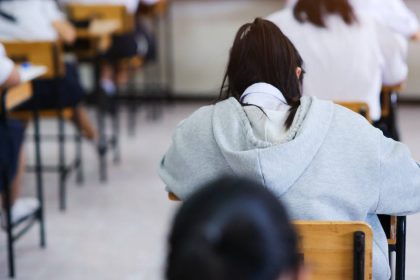The number of super-sized schools with 2000-plus students is growing. But is being a small fish in an increasingly big pond a positive for Australian students? Despite the marketing promises that many large schools make – promoting themselves as offering more opportunities and greater choice of subjects and activities – many families prefer the tailored attention small schools offer.
In Victoria, the number of schools with more than 2000 students has more than doubled in the past decade. In other capital cities and regional centres, too, bigger schools are becoming more common. It’s a trend that some experts say poses significant challenges for school leaders, with the issue of providing enough space to learn, as well as being able to nurture the social connections that come from feeling seen and known, as opposed to being lost in a large crowd, proving problematic for some students.
Super schools in growth corridors
Data from the Australian Curriculum, Assessment and Reporting Authority (ACARA) reveals that the number of Victorian schools with total enrolments of 2000 or more students has risen from 13 in 2012 to 34 in 2022. Many of these campuses are located in the rapidly booming growth corridors in Melbourne’s south-east and west. One example is Alamanda K-9 College in Point Cook, in the Victorian capital’s outer west, which listed 3351 enrolled students in 2022, less than ten years after opening in 2013.
In New South Wales, 2023 enrolment data at the start of this year showed Riverbank Public, in the north-west suburb of The Ponds, hit 2074 students, closely followed by Castle Hill High with 2049 students, and Cherrybrook Technology High with 2044 students. Across the state, independent schools are some of NSW’s biggest, with Knox Grammar in Wahroonga and Malek Fahd Islamic School in Greenacre – both kindergarten to year 12 schools – topping 3100 students each.
Larger schools demand effective management
For families worried about sending their children to larger schools, advocates for the super schools say, if they are set up properly, big schools could offer smaller hubs that would help students build close links with the local community.
According to Grattan Institute education programs director Jordana Hunter, well-managed larger schools can provide both teachers and students benefits. But. she said, principals of large campuses need leadership training and support to ensure effective management of the many moving parts.
Many families believe small schools are best
For many families, though, small schools offer a level of individualised visibility and attention they say is hard to match.
In a recently published paper examining the benefits of small schools in the US school system, a comprehensive review of the literature on the benefits of small (or smaller) schools, as compared to large- or middle-sized schools, in six key areas that are of national concern and of concern to every parent and school leader: (a) safety, (b) teaching conditions, (c) academic performance, (d) culture of connection and inclusiveness, (e) learning choices and curriculum, and (f) costs of schooling. The research shows, the paper reports, that small schools have very strong advantages in all areas, except for cost. However, the paper also concludes that “the issue of cost is inconclusive and in dire need of additional research”.
Bigger is definitely not better at independent girls’ school, Fintona, in Melbourne’s leafy eastern suburbs. Parents committed to the small school environment sing the praises of smaller classes that mean more personalised attention – as well as greater opportunities for leadership positions and genuine connections between staff, students and families. With 50 per cent of the class of 2023 achieving 95+ ATAR results this week, the academic achievements of this small school speak for themselves.
Another small independent girls’ school, Shelford Girls Grammar, also shone, when yesterday’s ATAR results were announced, with 54 per cent of students achieving a 90+ result, to help pave the way to the university courses of their choice.







